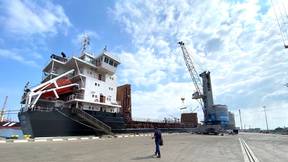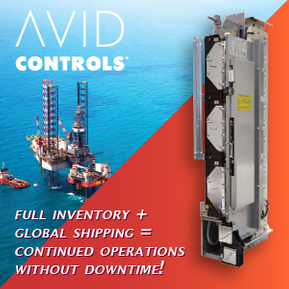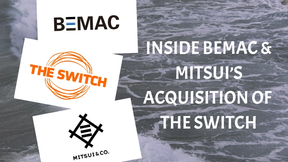Vast Opportunities Technology, economics buoy Gulf Coast prospects
"... The Gulf is back," according to William Charbonnet, spokesman for Power Offshore Services, Inc. Having been a less than dynamic industry for the last decade, the offshore market in the Gulf of Mexico is now experiencing an upswing. While this resurgence is expected to be a conservative one — due mainly to current legislative issues which threaten to stunt growth — it is anybody's guess as to how high the market will go, as project numbers increase, and the trend continues toward digging in deeper waters.
Touting new technologies and tracking increased newbuilding/conversion orders, oil companies, exploration companies and shipbuilders alike are prepared to ride a bull market throughout the next few years.
Deeper Digging Brings Action To The Surface The activity in the Gulf is at a level where supply and demand for equipment has reached a healthy balance for the first time in more than 10 years. Driving this activity is the price of oil and gas, as well as new technologies, such as deepwater drilling and production, and 3-D and subsalt seismic exploration. Mr.
Charbonnet said that oil companies, both major and independents, are increasing their exploration budgets and allocating them back to the Gulf of Mexico. Along with stabilized prices, production budgets have increased, he added.
The rise in interest in the Gulf of Mexico has also proven beneficial to oil service company Western Atlas Inc. "The Gulf of Mexico has become active in many areas for the oil and gas industry, all of which provide attractive opportunities for our clients: large, integrated oil companies; independents; and E&P (exploration and production) companies," said Dirk Koerber, vice president, Investor Relations, Western Atlas. These active areas are the transition zones (primarily Louisiana), deepwater, subsalt areas and shallow water exploration. According to John Chiannis, partner at Han-Padron Associates, consulting engineers, Han-Padron's primary focus is on the deepwater market, which is "doing very well." This is best exemplified by the amount of drilling projects the company has been working on, and the number of very large, complex, potential platforms. Han-Padron is collaborating with Shell, Amoco, Chevron and Exxon; all deepwater projects 3,400 to 4,700 ft. (1,036 to 1,432 m) depths — with the majority being tension leg platforms (TLP).
"Today's economy really moves oil companies to get these systems installed as quickly as possible," said Mr. Chiannis. The technology to streamline design and make computer links to complete projects in a shorter time frame with fewer people, thus providing more business, does exist. The faster these projects are implemented and brought on line, the greater the return on the equipment. For example, according to Mr. Chiannis, if one structure can be brought on line one month early, it translates into a savings of at least $3-7 million. This puts a lot of pressure on engineering companies like Han-Padron to design these systems as quickly as possible, and to speed-up the fabrication process. "Schedule compression" has become a key word at Han-Padron.
Hugh Thompson, a senior Facilities engineer at Chevron, corroborated Mr. Chiannis' views. According to Mr. Thompson, the deepwater market is improving due to a number of real/planned projects in Houston. There has been a significant increase in the number of these projects, as well as in deepwater lease sales.
He said that one thing that has led to an improvement in the offshore market is not so much the change in oil prices, but the discovery by Shell that flow rates are much higher, with a typical well producing 2,000 barrels of oil per day. This ameliorates the economics of projects in terms of improvements in facility costs. "The move to deepwater is due to advancements in geophysical technology," said Mr.
Thompson. Like Mr. Charbonnet of Power Offshore, he also believes that the use of 3-D and subsalt seismic is leading to a lot more activity in the Gulf. Mr. Thompson added that on facility side platforms, new concepts are resulting in cost savings.
These include Spars, Tension Leg Platforms (TLP), Floating Production and Storage systems (FPS) and Floating Production Storage and Offloading systems (FPSO) as the major floating production concepts for deepwater, with compliant towers being the primary bottom-founded production concept.
The resurgence in the Gulf is also substantiated by shipbuilders.
"The offshore market in the Gulf of Mexico is more active now than at any period of time since the late 1970s," said an optimistic Don Covington, president of Texas Drydock, Inc. (TDI). "Capital investments in acquisitions, mergers and equipment upgrades by the major drilling contractors indicate a confidence in the continued growth; and prices of crude and natural gas have stabilized at a level that encourages continued production." The rig repair/conversion market was relatively flat one to two years ago, with most of the work during that time being the repair and upgrade of jack-ups. Three Gulf Coast yards — Texas Drydock, Amfels and HAM — were the primary competitors for what offshore work was available. "With the increased demand for drilling in deeper water, the market for semisubmersible conversions has exploded, and big rig yards are now looking at backlogs of projects that extend into late summer of 1997," said Mr. Covington.
Peter Husta, director, Sales and Marketing, for Service Marine Industries, Inc., reports similar offshore conditions. The activities in the Gulf of Mexico are increasing significantly, as evidenced by the number of working platforms and rigs in use and currently under mobilization. As of early June, 63 of the 77 Gulf platform rigs were working under contract, according to Mr. Husta.
"Our customers are busy supporting drilling activities in progressively deeper waters. They are also being called upon to support different types of activities which require them to reconfigure their ships to meet the specific needs of the oil, drilling or seismic survey company. This level of activity is much higher than we've seen in the past three to five years," said Mr. Husta.
New Technologies Spawn New Business According to Mr. Koerber of Western Atlas, three major technologies have enabled oil companies to reduce their finding costs so much that the actual block price is less of an issue compared with three to five years ago. These technologies are: 3-D seismic, which cuts costs by reducing the number of dry holes, thus helping oil and gas companies to understand the reservoir better and increase production over the life of the field; horizontal/multi-lateral wells, which allow to cost-effectively drain leftover pockets of oil/gas in a proven field and drain new reservoirs more efficiently; and subsea completion systems, which reduce the cost of deepwater finds. In addition, special seismic technologies such as ocean-bottom cables have made the reshooting of congested production areas efficient, while also creating long-offset data. Processing methods such as pre-stack depth migration allow for identification of prospective structures below subsalt, and 4-D, or time-lapsed reshooting of a production reservoir, will allow the monitoring of a field and optimize production.
With all the new developments occurring in the offshore market, much activity has been generated for all sectors of the industry. "They're all busy: from drilling companies to pipe suppliers; from platform operators to marine transportation companies; from boat companies to shipyards," said Mr. Charbonnet. "Drilling rigs are working at record day rates. Oil companies are contracting rigs for multi-year contracts. Older rigs are being retrofitted to increase drilling capabilities. Supply boats are being built new, as well as being refurbished and lengthened to meet the demand for deeper water drilling. New platforms are being fabricated and installed, and most of the ship and fabrication yards are full." Another indication of increased activity is the liftboat industry. Power Offshore Services has started construction on the "next generation" liftboat, the Power 250. The company is currently building the first of three planned vessels of this class at its newly expanded shipyard, Semco, located in Lafitte, La. This vessel will reportedly be one of the largest liftboats in the world. With 250-ft. (76.2-m) legs, the Power 250 will reportedly be able to operate in 190-ft. (57.9- m) water depths. Living quarters will accommodate 66 persons, and an open deck area of 10,000-sq.-ft. will provide a deck load of 750,000 lbs. Two SeaTrax leg-mounted cranes will also be installed, each with a lifting capacity of 175 tons. "As platforms are installed in deeper water depths, those operators will need equipment available to them to service those structures. Several other liftboat operators are also apparently convinced, as there are presently four other large class liftboats under construction, and four more have been approved for a loan guarantee program by MarAd," said Mr. Charbonnet. Western Geophysical, the seismic division of Western Atlas, is planning what is predicted to be the largest deepwater 3-D seismic survey ever conducted in the Gulf of Mexico. Dubbed Ultra Survey, the project will cover approximately 1,000 offshore blocks in deepwater areas of the U.S. Gulf of Mexico Outer Continental Shelf. Several multi-streamer, high-capacity vessels will acquire 3-D seismic data encompassing approximately 9,000-sq.-mi. off the coast of Louisiana.
In all, 93 energy companies bid more than $700 million for licenses on 924 offshore blocks. The majority of those bids relate to blocks in the deepwater areas, almost 200 of which are located in the Green Canyon, Walker Ridge, Atwater Valley and Mississippi Canyon regions — the prime areas to be covered by Ultra Survey. The survey is expected to be completed in less than three years, with initial results delivered to customers before the end of this year. Spars International, a joint venture between J. Ray McDermott and Aker Oil and Gas Technology, has been awarded a contract valued at $300 million by Chevron for the fabrication and installation of the Genesis SPAR platform, a deepwater development in the Gulf. The hull is being built in Finland by Aker-Rauma Inc., and the deck at McDermott's Morgan City, La., facility. McDermott will install the Genesis SPAR — a steel cylinder measuring 705 ft. (214.8 m) in length and 122 ft. (37.1 m) in diameter — in 2,600 ft. (792.4 m) of water in Green Canyon 205, located approximately 150 miles south- west of New Orleans. This project is scheduled for completion in 1998.
According to Mr. Covington of Texas Drydock, semi-submersible and drillship conversions are underway or planned for 1996/97 for Diamond Offshore, Reading & Bates, Sedco-Forex, Sonat, Global Marine and Noble Drilling, along with several other semi-submersible contracts being considered.
TDI's current backlog includes: three semi-submersible and one jackup conversion for Diamond Offshore; two jackup conversions for Noble Drilling; one jackup conversion and one jackup refurbishment for Ensco Drilling; and one jack-up refurbishment for Cliffs Drilling. Mr. Covington added that numerous other conversions for both ships and semis are planned, but have not yet reached the contracting stage.
All Well At Shell Shell Oil Company has finalized development plans for Ursa — its $1.45-billion deepwater project. Ursa — which will be developed with a TLP in approximately 4,000 ft. (1,219.2 m) of water — is expected to achieve record deepwater production rates of 150,000 barrels of oil and 400 million-cu.-ft. of natural gas per day. Ultimate recovery from Ursa is estimated at approximately 400 million barrels of oil and gas equivalent.
"Ursa is another important advancement in the evolution of deepwater development," said Rich Pattarozzi, general manager of Shell Offshore Inc., Deepwater division. "The platform will be the largest structure in the Gulf of Mexico, and its individual wells are expected to produce at rates not thought possible just a few years ago." Ursa's current development plans include as many as 14 wells, some reportedly producing with initial rates of up to 30,000 barrels of oil per day. The highest individual well rate achieved to date is approximately 13,000 barrels per day at Shell's Auger project in the Gulf.
Regulatory Hang-ups Despite all the offshore activity taking place and planned in the Gulf, legislative obstacles must be overcome. "A lot of the industry is waiting for there to be a definition of what an offshore supply boat is when you relate it to the International Tonnage Convention," said Charles Burrell, sales manager at Leevac Shipyard Inc. Currently, all vessels built today, intended to be used in international markets either now or in the future, need to be built to meet all international regulations (including SOLAS). But as U.S. manning requirement regulations of today read, if a vessel is more than 500 gt, it is no longer a supply boat. Thus, the problem arises that a typical supply boat of less than 500 gt domestic may be 13,000 to 18,000 gt international. According to Mr. Burrell, this, in effect, forces builders to add tonnage steel which does nothing but cost money, in order to meet domestic tonnage requirements.
Bob Alario of Offshore Marine Service expanded on this legislative debate: "The problem is that recent ratification of the international tonnage convention has created a dilemma in that we have to comply with an International Tonnage System, but there is no domestic requirement to correspond. The international standards (effective 1994) and domestic laws and regulations are not compatible. "We need to harmonize the two through the U.S. Coast Guard Authorization Bill which is presently stalled in service. We need this bill passed in order to set up alternate tonnage measurements for offshore vessels without confusion with respect to building and manning the vessels.
"Right now we are in a twilight zone where we can not make business judgments with respect to which rules and statutory roots determine what a vessel can be, should be, and will be.
Considerable amounts of construction are being held up because you need to be two contradicting things," said Mr. Alario. At press time, Mr. Alario was hopeful that before its August recess, Congress would take action and pass the provisions needed in order to design and construct the offshore vessels of the future.
While definitive questions in the market remain, industry leaders agree on a positive future for the offshore market in the Gulf of Mexico. "As to the future, we take our cue from the drilling contractors who, at this time, are highly optimistic. It is obvious that unless they (industry leaders) have totally misjudged the future market, they are not investing hundreds of millions of dollars based on short-term prosperty," said Mr. Covington. According to Mr.
Charbonnet, with world consumption of oil increasing at the rate it is, the industry must continue to find large produceable sources to meet the demand. There will be a lot of activity just completing the current work in progress, as well as the recent announcements of deepwater discoveries in the Gulf. Mr. Husta offered a positive summation of the market's future: "I personally believe that this level of activity will be sustained for a while.
There are a significant number of offshore blocks which have yet to be worked. The level of seismic survey activity indicates that there should be a continued effort to hit 'pay' in the Gulf of Mexico over the near term."




